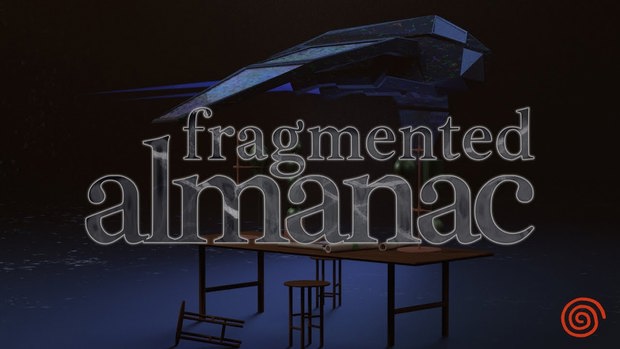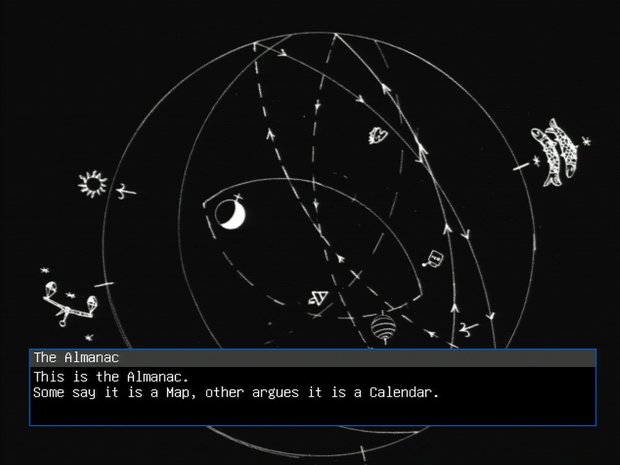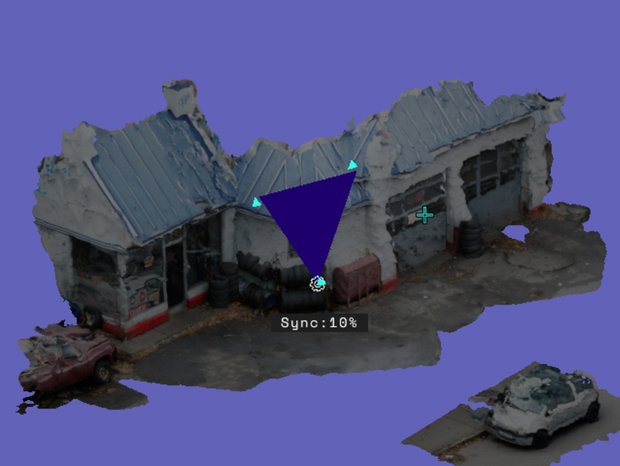Fragmented Almanac review

- 0 Comments
This new Sega Dreamcast exclusive may be short but has some intriguing pieces to thumb through
It may not have been the most commercially successful console, but for those who had one, the Sega Dreamcast is fondly remembered. Its hardware was based on the Naomi arcade board, allowing for easy porting of the latest arcade hits, and with keyboard and mouse support, VGA output, a built-in 56k modem, Windows CE, and browser and email functions to complement online gameplay, it was comparable to PC systems of the time, too. Yet, even as a PC substitute in many ways, its library lacked adventure titles.
Fortunately, the fan-development scene has remained active since the console’s official discontinuation some twenty-five years ago. While the adventure genre didn’t have a strong presence on the Dreamcast during its official lifespan, the independent scene has tried to rectify that over the past several years. ANTIRUINS’ Fragmented Almanac is the latest of these fan productions, bringing some much-needed point-and-click adventuring content to the console. Strong artistic design and inventive puzzles make the game enjoyable to play, though inconsistent performance, a short runtime, and translation errors somewhat diminish this well-intentioned addition to the Dreamcast library.
Fragmented Almanac is, as the title suggests, a series of fragments – well, two, to be exact. The game opens with a pre-rendered stone fist rising onto the screen. The fist then opens, manifesting into a sort of main menu. Icons hover over each fingertip, granting access to different parts of the game. One of these options is simply a media player, allowing you to listen to the soundtrack, while another two are part of the “game” proper, with the last being the almanac.

Selecting the latter prompts a brief animated sequence of a sort of celestial map, with objects and symbols in place of planets, orbiting in their own unique patterns. This map is introduced as the almanac via a brief written overview before allowing players to observe it more closely, clicking on the various symbols to obtain information – assuming this information has been unlocked. Playing through the game itself unlocks rendered images and short descriptions associated with these symbols (eight in total), making it best to explore the almanac after you have completed one of the two “games,” though you can return to it at any point.
The almanac makes for a purposefully vague overarching narrative, but is nonetheless intriguing, making the game feel bigger than its short gameplay segments. There are several grammatical errors in the subtitles for this sequence, however, and this holds true for text in the rest of the game as well, though they are not so egregious as to be confusing.
The first game listed in the main menu is titled “The Hideout,” though you don’t need to play them in any specific order. A short introductory movie with a voice-over depicts an experiment of sorts transpiring before dumping players into the action proper. Here you view the world from an isometric perspective and control a floating apparition that has seemingly just escaped from a glass flask in an alchemist’s workstation. You wander around the room, looking at bookshelves, scrolls, and mysterious artifacts strewn about in an effort to decipher what has transpired here.

This game is navigated via the Dreamcast controller, using A to interact and the D-pad or stick to move your avatar about, which doubles as the cursor. Though you can look at objects by maneuvering over them and pressing the action button, you cannot physically manipulate anything in the world due to your ethereal state. The protagonist’s memory also has holes in it, remembering only that they were involved in some sort of experiment.
As you wander about the laboratory, you’ll uncover more clues to what exactly occurred here, although the ultimate conclusion is left intentionally ambiguous. There is no hotspot indicator, nor is it immediately evident which objects are interactive and which are not, but the layout of the laboratory is small enough that discovering all points of interest is relatively simple. Some objects will only prompt a passing comment from your avatar initially, though after inspecting other objects you can return to previously examined points and obtain new information. Pausing the game shows a sort of quest log indicating your current objective should you become lost.
Composer Gabriel Ledoux’s gentle electronic instrumentals play constantly during “The Hideout,” and are the only sounds of note. They suit the atmosphere perfectly, lending the room a mysterious ambience while also being nice to sit and listen to while pondering clues. The plasma ball avatar is translucent, which is a nice effect. However, your avatar moves at the same speed and height no matter the topography, making it appear as though it is just floating over a flat image. And while it casts a shadow on the floor, this shadow disappears when passing over other objects in the room, like walls or furniture. Adjusting the avatar and its shadow to mimic them rising or sinking over different objects would have been a nice touch.
Escaping the room requires you to obtain a series of sigils and an associated pattern of button presses, which are then input into a magical floating box in the centre of the laboratory. Successfully completing this task will prompt a CG cinematic, after which you are kicked back to the main menu. While the cinematic doesn't really provide any answers or clarity to the overarching story, it's a nice reward for completing the segment.
The puzzle design in this particular game is well-executed, delivering clues via diagrams and written notes, requiring some brainpower and probably a notepad but not being so obtuse as to stall you for long. Though your progress is automatically saved at each critical clue or puzzle solved, it’s reset each time you quit. Fortunately, Fragmented Almanac has been built to run on Dreamcast emulators as well as real hardware, meaning those emulating the game can use save states to take breaks midway.
“Summoning Signals” is the second game in Fragmented Almanac, which opens with a psychedelic pre-rendered video of a travelling spacecraft that crash-lands on a remote planet. This game plays similarly to “The Hideout” insofar as it is an isometric adventure. Stylistically, however, it is quite different, as the environment here is totally surreal. Instead of guiding a floating ball of plasma, you merely control a crosshair cursor representing the pilot. “Summoning Signals” takes place over a much larger series of areas as well, as opposed to a single room. These backgrounds are divided into slivers of land, with a radical colour-changing void in between. Though you do not see your avatar this time, they do provide a monologue, just like in “The Hideout.”

The goal here is simply to repair your ship, but to do so you must navigate a strange kingdom currently under construction. Travelling between ladder and plank walkways, a castle, and the ruins of a contemporary city, you’ll seek out all of the parts needed to get your vessel back in space.
Unlike in “The Hideout,” the pilot protagonist can physically interact with the environment (via the cursor, which does connote the objects that can be interacted with by changing colour when overtop hotspots). You also have a proper inventory, with your primary pieces of equipment being a repair kit and radio. The radio can be attuned to different frequencies to search for broadcasts in various places, which may give you guidance on where to go next. The repair kit can be used to fix certain machines via a mini-game requiring you to match three points of a triangle to a moving target.
Both are well-utilized in puzzle design throughout, though they are not the only types of challenges you’ll face. You’ll also need to exchange items and services with NPCs to access new areas, or search for keys to locked doors. With the map being so small, and the points of interaction so limited in number, it’s rarely difficult to find where to go, though the pause menu contains a quest log outlining what needs to be completed should you ever get lost. The only real anomaly is an arcade SHMUP game where you are challenged to defeat a two-headed dragon with your spaceship. It requires perhaps a bit more dexterity than the average adventure gamer may be comfortable with, but it is nevertheless a fun distraction.

Curiously, this game is also segmented into multiple parts. Upon completing the first chapter of “Summoning Signals,” you are kicked back to the main menu where you select which area you want to explore. It’s strange that all of these areas aren’t linked together in-game, but it only interrupts the experience momentarily.
Though you move your cursor around the screen in a similar manner to “The Hideout,” “Summoning Signals” makes welcome use of feedback and invisible barriers to give the cursor more weight, almost like an on-screen character rather than just a cursor. It moves at a slow pace and is blocked from going too far off the solid land masses, for example, effectively making it feel as though you are in fact walking through an area, and not just clicking on it. Travelling between screens is done by finding an arrow marker connoting passage to another area. As you progress, more of Ledoux’s calm synth music immerses you once again into the radical environments, bridging the gap between the game’s ancient and futuristic visuals.
Several pre-rendered movies play in “Summoning Signals” as well. These are beautiful to behold as they don’t simply use faux-retro filters to replicate a low-resolution look, but real hardware rendering within its limitations, effectively emulating a turn-of-the-millennium gaming experience. Though “The Hideout” is interesting to explore for the brief time it lasts, “Summoning Signals” is the more inventive and attractive event in Fragmented Almanac.
“Summoning Signals” also features manual save states, though it probably doesn't hurt to play on an emulator with alternate save states just in case you experience glitches. Sometimes parts of the inventory would cease to work for me. The radio graphic, for example, failed to load several times. I could still hear the sounds associated with it, indicating that it had in fact loaded upon my selecting it from the inventory, but the visual was entirely absent, making it impossible to use.
While not a glitch, how puzzle solutions in “Summoning Signals” are triggered is inconsistent. Some merely require you to click on a point that needs an object or key in order to progress, while others require you to manually select an object from your inventory and then the point in the environment in order to activate it. Considering how short the game is, this isn’t a huge deal, but it would have been nice to have the function more clearly laid out.
Final Verdict
ANTIRUINS has admittedly just mashed two development projects into one in an effort to show off their engine for developing Dreamcast software, but that’s not to say the game lacks imagination. The almanac itself is a great device for linking these stories together, and I genuinely enjoyed my time with both of its two different games – when they were working properly, that is. If you can stomach a few minor technical instabilities, and don’t mind that the experience is incredibly short (it took me just over an hour and a half my first playthrough, and not even half that for my second), Fragmented Almanac is worth the price of admission, regardless of whether you’re a Dreamcast aficionado playing a novelty hard copy, or just a point-and-click fan looking to see what the independent scene is producing on old hardware. It may be more of a technical exercise showing what kinds of adventure games can be built on the system, but as a finished production in its own right, it is nonetheless artistically striking and enjoyable to explore.
Hot take
Fragmented Almanac is an intriguing new addition to the Dreamcast’s small adventure library. It can feel like more of a tech demo than a fully realized game, but with two different gameplay types to experience, the end result is enjoyable enough for the brief time it lasts.
Pros
- Vague but interesting overarching narrative
- Beautiful pre-rendered visuals
- Haunting, immersive soundtrack
- Challenging but mostly sensible puzzle design
Cons
- Very short runtime, even with two separate gameplay experiences
- Inconsistent use of inventory when applying items to solve puzzles
- Some glitches remain
Drew played Fragmented Almanac











0 Comments
Want to join the discussion? Leave a comment as guest, sign in or register.
Leave a comment